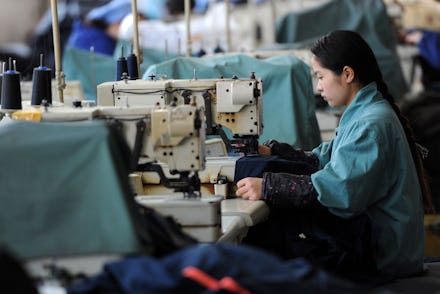Triangle Shirtwaist Factory Fire Was 105 Years Ago — So Why Are Tragedies Still Happening?

Most people who have taken an American History course have learned about the Triangle Shirtwaist Factory fire of 1911. The historic fire — which happened 105 years ago today — killed 146 garment workers at a factory in New York City. It was one of the deadliest industrial disasters in United States history, and it sparked legislation that continues to protect workers to this day.
Except, well, not all workers — and not everywhere.
Despite its historical significance, the circumstances of the Triangle Shirtwaist Factory fire and its implications are hardly things of the past. In fact, despite efforts to protect American workers, overseas laborers — who are responsible for most of the clothing we wear today — face a situation not unlike that of the Triangle workers 105 years ago:
Factory conditions are putting workers at risk, and most of those workers are women.
Still high demand, still poor conditions — except now, it's overseas: The Triangle Shirtwaist Factory, located in downtown New York City, made shirtwaists, a type of blouse that had grown popular among women from upper and lower classes, which made the demand for the garment very high.
To meet this high demand, factory workers worked 13-hour days for just 13 cents an hour, and in environments that were unsanitary and dangerous thanks to the carelessness of the factory's owners. Poor ventilation was common, and bosses often locked the doors in order to prevent workers from leaving or taking bathroom breaks — which led to tragedy when a fire broke loose in the factory on March 25, 1911.
But such extreme disregard for workers' safety still occurs, and such hazardous conditions that frequently result in disaster are not yet eradicated. Several stories of deaths in which employees were locked within factories have made headlines over the last five years, from the November 24, 2012 fire at the Tazreen Fashions factory in Bangladesh, to the September 11, 2012 fires at a textile factory complex in Pakistan.
The most famous garment factory tragedy was the 2013 collapse of Rana Plaza, a building in Bangladesh containing factories with about 5,000 workers. Just as in 1911, the bosses in charge were aware that conditions were risky.
According to the New York Times, "owners of the factories urged employees to return to work even after an engineer inspected the building the day before the collapse and deemed it unsafe." After the fact, 18 people were charged with building code violations.
But demand drives a production-at-all-costs mentality; today, there is an even bigger global demand for stylish garments as there was for the shirtwaist in the early 20th century. Fast, disposable fashion (think the like of H&M and Forever 21) has become the norm, and workers who produce these garments are often forced to work insane hours to meet quotas.
And because price has driven manufacturers overseas (97% of clothing sold in the U.S. is imported, according to a 2014 report), the labor regulations passed in the wake of the Triangle factory tragedy don't apply. Thus, we're often unable to see the harm done with our own eyes.
Women are still the ones who suffer most: One fact that made the Triangle Shirtwaist Factory fire story so emotionally gripping was that the majority of the workers killed were young women — 129 of the 146 workers killed were women, the majority of them ages 16 to 23. The youngest woman killed was a 14-year-old girl.
Today, women still make up the majority of garment workers: An estimated 80% of garment workers around the globe are female. As Mic reported last November, this is largely because factory owners often believe that female employees are "more docile and, therefore, willing to work longer hours for less pay, without organizing or trying to change their conditions."
The thousands of women working in garment manufacturing in countries like Cambodia, Bangladesh and China frequently receive impossibly small wages and face sexism and oppression in the workplace. And because these women are living in countries with some of the highest rates of poverty, there are often few alternatives — a fact employers take advantage of.
Just like in 1911, however, the women of these factories have begun to organize for change. Before the Triangle Shirtwaist Factory incident, female garment workers were already demanding better working conditions. A strike in 1909 led to an agreement between owners and workers that improved wages and hours. The fire then helped bring the issues to light even more, especially in the media, leading to legislation that cemented workplace safety and workers' rights into law.
The circumstances of present-day workers are arguably more complicated, and the issue extends far beyond a single city. Despite fear of repercussions — including losing the only job they're qualified for, and even physical violence — in countries like Bangladesh, some women are fighting for change by becoming leaders in unions or participating in strikes.
Meanwhile, more fashion brands are becoming "socially responsible," and consumers are dabbling in "ethical shopping"; still, thanks to globalization, the issues are far from the U.S., where factory fires 105 years ago brought progress other countries still haven't seen.
Just as they were in 1911, feminist issues and labor issues are often linked, but in 2016, what we need to solve this feminist issue is not only worker solidarity, but solidarity among workers, consumers and anyone who cares about the well-being of women.